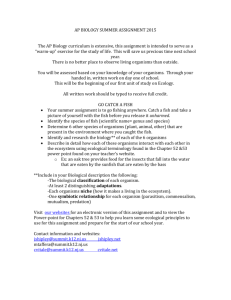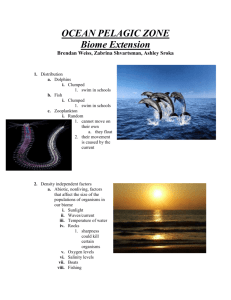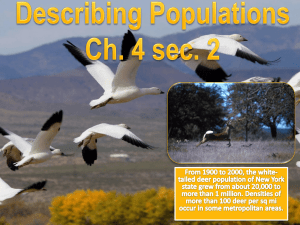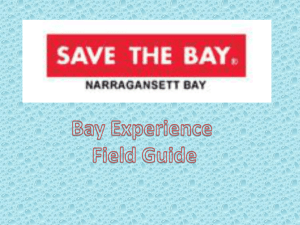Intertidal zone ~ Biome Extension
advertisement
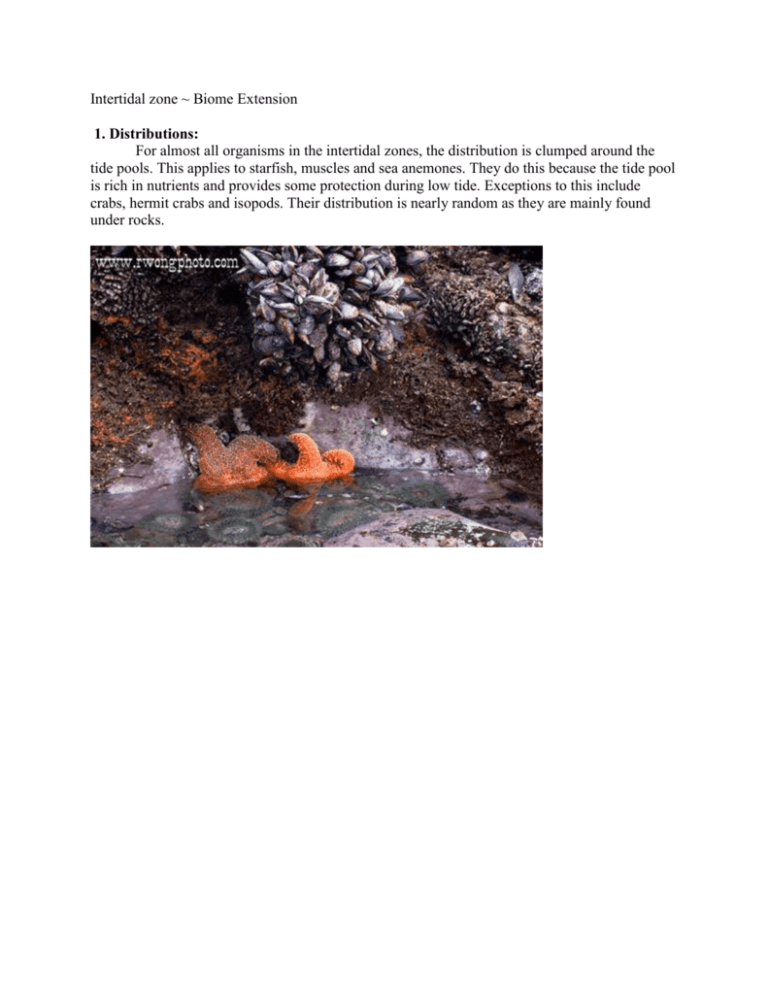
Intertidal zone ~ Biome Extension 1. Distributions: For almost all organisms in the intertidal zones, the distribution is clumped around the tide pools. This applies to starfish, muscles and sea anemones. They do this because the tide pool is rich in nutrients and provides some protection during low tide. Exceptions to this include crabs, hermit crabs and isopods. Their distribution is nearly random as they are mainly found under rocks. Density Dependant: Size of tide pool Amount of pools Water level Over reproduction Over predation Disease Density Independent: Weather Pollution from humans The tide cycles Organisms being separated and preventing reproduction 3. Reproduction type Mussels They are R selected populations because they produce a lot of offspring due to threats of predators. Predators are organisms that consume other organisms, or biotic (living) components. This mass reproduction is an attempt to have some survivors that can reproduce, or create offspring. Sea stars They are R selected populations because they produce many eggs. They lay over two million eggs at one time and most of them hatch, but few survive because they grow on plankton. Plankton is a group of microscopic, or extremely tiny, algae and protozoa clumped together and it is a popular food source for many sea-dwelling organisms. Algae is a group of a mainly aquatic plant that produces its own food through photosynthesis, a process in which plants take in water, sunlight, and CO2 to make O2 and glucose, a sugar. Protozoa are mostly unicellular (single celled) organisms that can’t use photosynthesis. Hermit Crabs They are also R selected populations because of their mass spawning on beaches. The eggs are then carried out to the ocean by waves, where they hatch. As the eggs are carried out to the ocean, other organisms, or biotic (living) beings, attempt to consume them. The mass spawning is an attempt to make sure that at least some of the hermit crabs hatch, mature, and reproduce, or create offspring. 4. Symbiosis Commensalism- an organism living with, on, or in another organism without injury to either itself or the other organism. An example of this in an intertidal zone is sponges and crustaceans. Sponges live on a clam’s shell, but neither harm nor help them. Therefore, sponges live on crustaceans without injury nor benefit to them and are thus, commensalism. Mutualism-a relationship between two species of organisms in which both benefit from the association. An example of this is cleaner shrimp, fish, and fungal growth. Cleaner shrimp eat the fungal growth off of other fish. They benefit by receiving their food this way and the fish benefit by getting rid of their fungal infection. Thus, this is an example of mutualism. Parasitism-a relationship between organisms in which one lives as a parasite and harms the other organism. An example of this is round worms on fish. Round worms sap the nutrients from the intestines of fish. By stealing their nutrients, they steal the fish’s food and are able to feed themselves. Because the worm benefits from receiving the food, and the fish suffers, it is an example of parasitism. 5. Batesian Mimicry – resemblance of a harmless species of a species that is avoided by predators. An example, though not in our biome, is the king snake. The king snake resembles a Coral Snake which is a harmful species to predators. Therefore, the king snake uses Batesian Mimicry. Cryptic Coloration-a color that conceals or disguises an organism’s shape. In our biome, shellfish use this. Shellfish can blend into sand and rocks, disguising it’s shape. Thus, they use Cryptic Coloration. Deceptive Markings – markings that trick predators. Mollusks use this. Some have large, fake eyes or false heads to throw off predators. Mullerian Mimicry – resemblance of two or more unpalatable species which are avoided more than one the species. Flatworms mimic sponges to avoid predators. Predators don’t eat sponges, so by mimicking sponges, flatworms protect themselves and avoid predation.


